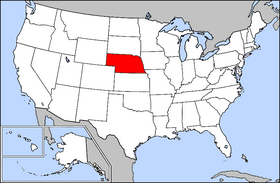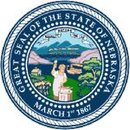Nebraska
|
|
| |||||
| State nickname: Cornhusker State | |||||

| |||||
| Other U.S. States | |||||
| Capital | Lincoln | ||||
| Largest city | Omaha | ||||
| Governor | Dave Heineman | ||||
| Official languages | English | ||||
| Area | 200,520 km² (16th) | ||||
| - Land | 199,099 km² | ||||
| - Water | 1,247 km² (0.6%) | ||||
| Population (2000) | |||||
| - Population | 1,711,263 (38th) | ||||
| - Density | 8.6 /km² (42nd) | ||||
| Admission into Union | |||||
| - Date | March 1, 1867 | ||||
| - Order | 37th | ||||
| Time zone | Central: UTC-6/-5 (eastern) Mountain: UTC-7/-6 (western) | ||||
| Latitude | 40?N to 43?N | ||||
| Longitude | 95?25'W to 104?W | ||||
| Width | 340 km | ||||
| Length | 690 km | ||||
| Elevation | |||||
| - Highest | 1,653 m | ||||
| - Mean | 790 m | ||||
| - Lowest | 256 m | ||||
| Abbreviations | |||||
| - USPS | NE | ||||
| - ISO 3166-2 | US-NE | ||||
| Web site | www.state.ne.us | ||||
Nebraska a midwestern State of the United States, Nebraska gets its name from a Native American (Oto) word meaning "flat water", after the Platte River that flows through the State. Once considered part of the Great American Desert, it is now a leading farming state. Nebraskans have practiced scientific farming to turn the Nebraska prairie into a land of ranches and farms. Much of the history of the State is the story of the impact of the Nebraska farmer.
| Contents |
History
The Kansas-Nebraska Act became law on May 30, 1854 which established the US territories of Nebraska and Kansas. The territorial capital of Nebraska was Omaha.
In the 1860s, the first great wave of homesteaders poured into Nebraska to claim free land granted by the federal government. Many of the first farm settlers built their homes out of sod because they found so few trees on the grassy land.
Nebraska became the 37th state in 1867, shortly after the Civil War. At that time, the capital was moved from Omaha to Lancaster, later renamed Lincoln after the recently assassinated President Abraham Lincoln.
Arbor Day began in Nebraska. The National Arbor Day Foundation is still headquartered in Nebraska City.
The adoption of national prohibition in 1918 with Nebraska as the thirty-sixth state necessary to make prohibition a part of our constitution. [1] (http://www.rootsweb.com/~neresour/OLLibrary/Journals/HPR/Vol06/nhrv06pc.html)
"Rural flight"
Nebraska, in common with five other Mid-West states (Kansas, Oklahoma, North and South Dakota and Iowa), is feeling the brunt of falling populations. 89% of the total number of cities in those states have fewer than 3000 people; hundreds have fewer than than 1000. Between 1996 and 2004 almost half a million people, nearly half with college degrees, left the six states. "Rural flight" as it is called has led to offers of free land and tax breaks as enticements to newcomers. As an example in Nebraska, Monowi, which in the 1930s had a population of 150, now (2005) has a population of one.
Law and Government
See: List of Congressmen and List of Governors
Nebraska is the only state in the United States with a unicameral legislature, that is a legislature with only one house. Although this house is known simply as the "Legislature", its members still call themselves "senators". Nebraska's Legislature is also the only one in the United States that is nonpartisan. The senators are elected with no party affiliation next to their names on the ballot, and the speaker and committee chairs are chosen at large, so that members of any party can be (and often are) chosen for these positions. The Nebraska legislature can also override a governor's veto with a 3/5ths majority, in contrast to the 2/3rds majority required in some other states.
For years, United States Senator George Norris and other Nebraskans encouraged the unicameral referendum. Norris argued
- ...The constitutions of our various states are built upon the idea that there is but one class. If this be true, there is no sense or reason in having the same thing done twice, especially if it is to be done by two bodies of men elected in the same way and having the same jurisdiction.
Unicameral supporters also argued that a bicameral legislature had a significant undemocratic feature in the committees that reconciled Assembly and Senate legislation. Votes in these committees were secretive, and would sometimes add provisions to bills that neither house had approved. Nebraska's unicameral legislature today has rules that bills can contain only one subject, and must be given at least five days of consideration.
Finally in 1934, due in part to the budgetary pressure of the Great Depression, Nebraska's unicameral legislature was put in place by a state initiative. In effect, the Assembly (the house) was abolished; as noted, today's Nebraska state legislators are referred to (especially by themselves) as "Senators".
Since 1991, two of Nebraska's five electoral votes are awarded based on the winner of the statewide election; the other three go to the highest vote-getter in each of the state's three congressional districts. For the last four elections, Republicans have won all of Nebraska's electoral votes, and no Democrat has carried the state since Lyndon Johnson.
Geography
National-atlas-nebraska.PNG
Nebraska is bordered by South Dakota to the north; Iowa and Missouri to the east, across the Missouri River; Kansas to the south; Colorado to the southwest, and Wyoming to the west. The largest city in Nebraska is Omaha, and the capital is Lincoln. The state has 93 counties; see List of Nebraska counties.
In regional terms, Nebraska is located in the Great Plains, at the westernmost extent of the Grain Belt. The eastern portion of the State could be considered part of the "Midwest", while the western and central portions are part of the "West", although the distinction between these regions is somewhat fluid. Indeed, one of Nebraska's mottos is "Where the West begins", and a local legend even has it that the West begins precisely at the intersection of 13th and O Streets in Lincoln (where it is marked by a red brick star).
Nebraska is one of the six states of the Frontier Strip.
Economy
The Bureau of Economic Analysis (http://www.bea.gov/) estimates that Nebraska's total state product in 2003 was $66 billion. Per capital personal income in 2003 was $30,179, 24th in the nation. Nebraska is known for its agriculture, especially beef and corn (aka maize).
Demographics
According to the Census Bureau, as of 2003, the population of Nebraska was 1,739,291.
The racial makeup of the state is:
- 87.3% White
- 5.5% Hispanic
- 4% Black
- 1.3% Asian
- 0.9% American Indian
- 1.4% Mixed race
The five largest ancestry groups in Nebraska are: German (38.6%), Irish (12.4%), English (9.6%), Swedish (4.9%), Czech (4.9%).
Religion
The religious affiliations of the people of Nebraska are:
- Christian – 90%
- Protestant – 61%
- Lutheran – 16%
- Methodist – 11%
- Baptist – 9%
- Presbyterian – 4%
- Other Protestants/general Protestant – 21%
- Roman Catholic – 28%
- Other Christian – 1%
- Protestant – 61%
- Non-Christian Religions – 1%
- No Religion – 9%
Interstates
- Interstate 80
- Interstate 76
- Interstate 129
- Interstate 180 (Lincoln spur)
- Interstate 480 (Metro Omaha loop)
- Interstate 680 (North Omaha loop)
Important cities and towns
Largest cities and towns
Largest urban areas
- Omaha metropolitan area (including Bellevue, Papillion, and La Vista)
- Lincoln metropolitan area
- Grand Island area
- Kearney area
- Fremont area
- Hastings area
- North Platte area
- Scottsbluff-Gering area
- Norfolk area
- Columbus area
Education
Colleges and universities
Sports teams
- Nebraska Cornhuskers, college football
- Omaha Royals, minor league baseball
- Lincoln Saltdogs, minor league baseball
- Creighton Bluejays, college basketball
- Omaha Beef, Arena Football
- Lincoln Stars, United States Hockey League
Climate
Nebraska generally has cold winters and warm summers. It is located on the edge of Tornado Alley
Miscellaneous information
Nebraska has 25 official state symbols, including the Platte River, the mammoth, and John Neihardt.
The USS Nebraska was named in honor of this State.
Nebraska is also the name of a 1982 album by Bruce Springsteen, widely considered one of his best.
Kool-Aid was created by Edwin Perkins in Hastings, Nebraska.
The world's largest train yard, Union Pacific's Bailey Yard, is located in North Platte, Nebraska
Former President Gerald R. Ford, Vice President Dick Cheney, civil rights activist Malcolm X, and various celebrities including Adele & Fred Astaire, Marlon Brando, Johnny Carson, Dick Cavett, Montgomery Clift, Henry Fonda, Harold Lloyd, Darryl F. Zanuck , Swoosie Kurtz and Hillary Swank were born in the state. Other famous natives are film director Alexander Payne, singer/musician Conor Oberst, College Football Hall of Fame Coach Dr. Tom Osborne, and athletes Gale Sayers, Bob Gibson, and Ahman Green. The world's second wealthiest person, billionaire investor Warren Buffett, was born in and still resides there.
- For complete list of famous people from Nebraska see: List of people from Nebraska
Clip Art and Pictures
- Free Clipart (http://classroomclipart.com)
State Maps
- US State Maps (http://classroomclipart.com/cgi-bin/kids/imageFolio.cgi?direct=Clipart/US_State_Maps)
- Printable Black and White Map of Nebraska (http://www.lessonplancentral.com/statemaps/nebraska_mapBW.htm)
State Flags
- US State Flags (http://classroomclipart.com/cgi-bin/kids/imageFolio.cgi?direct=Clipart/State_Flags)
Lesson Plans, Resources and Activites
- Lesson Plan Central (http://lessonplancentral.com)
External links
- http://nebraska.gov - Official government web site
- US Census Bureau (http://quickfacts.census.gov/qfd/states/31000.html)
| Political divisions of the United States | 
| ||||||
|---|---|---|---|---|---|---|---|
| |||||||



